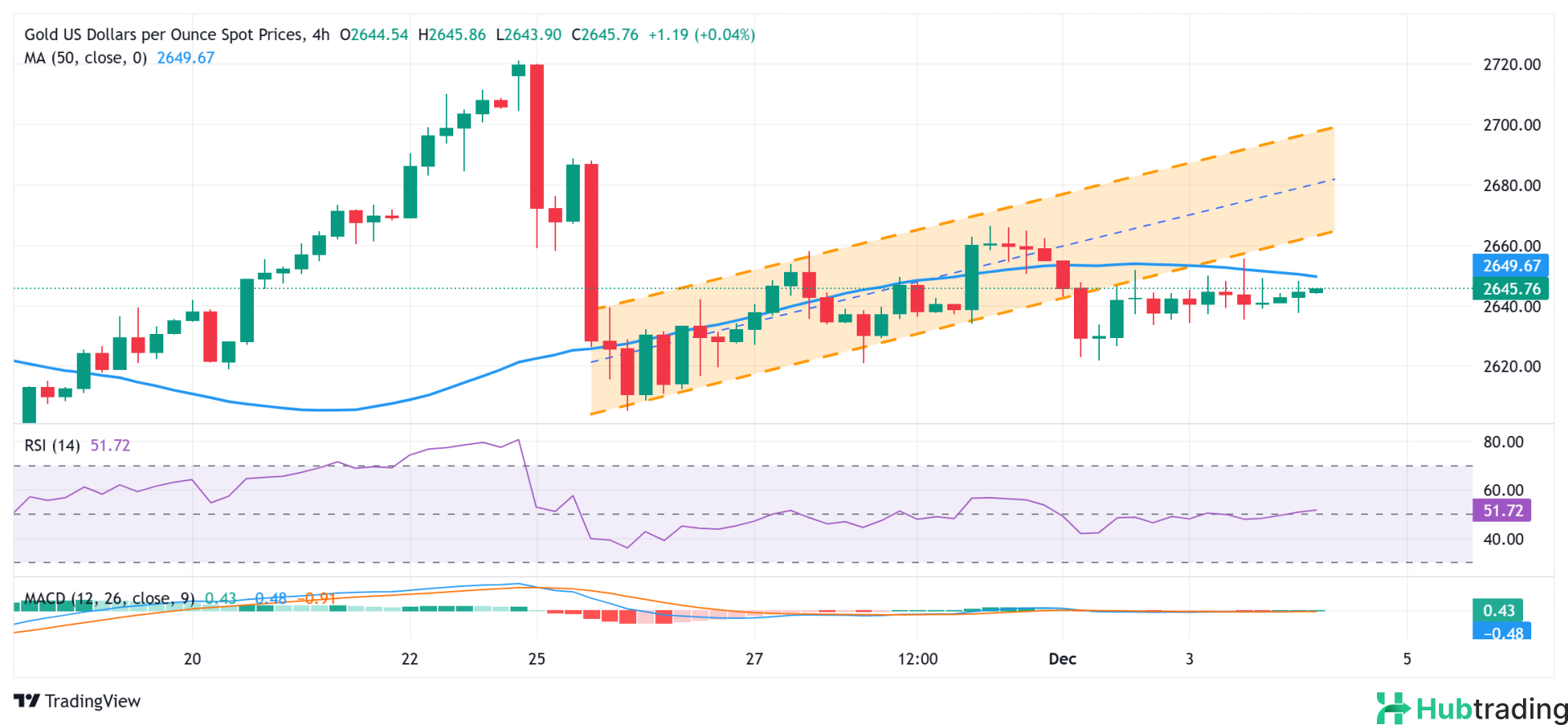- Gold prices extend gains for a second consecutive day, supported by safe-haven demand.
- Geopolitical tensions and trade war concerns bolster the metal, alongside muted USD demand.
- However, expectations of a less dovish Fed and rising US bond yields limit XAU/USD’s upside potential.
Gold price (XAU/USD) attracts buyers for a second consecutive day on Wednesday but remains range-bound within familiar levels seen over the past week. Geopolitical tensions and concerns over US President-elect Donald Trump's tariff plans, coupled with political instability in South Korea, continue to support safe-haven demand for the precious metal. However, the upside remains limited as investors await Federal Reserve (Fed) Chair Jerome Powell's speech for insights on the future rate-cut trajectory, which could provide clearer direction for the non-yielding asset.
Meanwhile, expectations that the Fed may take a cautious approach to rate cuts, given fears of inflationary pressures from Trump’s policies, have driven a modest rise in US Treasury bond yields. This dynamic offers support to the US Dollar (USD), adding further pressure on Gold prices. In the near term, traders are eyeing the US ADP private-sector employment report and ISM Services PMI for opportunities, while the focus remains firmly on Friday’s Nonfarm Payrolls (NFP) report for broader market cues.
Gold Price Stalls as Market Awaits Powell’s Speech and Fed Rate Outlook
- Gold price movement remains subdued, with bulls showing little commitment amid expectations of a less dovish Federal Reserve (Fed). Traders are refraining from making aggressive bets ahead of Fed Chair Jerome Powell’s upcoming speech, which could provide clarity on the central bank’s interest rate trajectory.
- On Tuesday, the JOLTS report from the US Bureau of Labor Statistics (BLS) revealed a strong rise in job openings, increasing from 7.37 million to 7.74 million in October.
- This robust labor market data, coupled with stalled progress in reducing inflation to the 2% target, suggests that the Fed may pause its rate-cutting cycle next year.
- Despite this, markets are pricing in over a 70% likelihood of a 25 basis-point rate cut at the December Fed meeting, according to the CME Group’s FedWatch Tool.
- Fed officials remain divided on the outlook: San Francisco Fed President Mary Daly noted the balanced labor market is not driving inflation, keeping a December rate cut on the table.
- Fed Governor Adrianna Kugler emphasized a data-dependent approach, while Chicago Fed President Austan Goolsbee argued for a significant reduction in rates over the next year if inflation trends toward the target.
- US Treasury bond yields have seen a modest uptick amid these dynamics, though this has done little to bolster the US Dollar or spark significant movement in gold prices.
- Adding to market uncertainty, geopolitical risks remain in focus. President-elect Donald Trump has pledged sweeping tariffs against Mexico, Canada, and China, along with a 100% tariff on BRICS nations, fueling concerns of escalating trade tensions.
- In the Middle East, Israel launched its largest airstrike since a truce with Lebanon, responding to rocket attacks from Hezbollah.
- China’s Caixin Services PMI unexpectedly declined to 51.5 in November from 52.0, raising concerns about the fragile recovery in the world’s second-largest economy. These developments contribute to a cautious trading environment as investors await key economic and geopolitical developments.
Gold Price Technical Outlook: Bulls Need to Overcome $2,655-$2,666 Resistance

From a technical standpoint, the recent range-bound price action in gold may still be seen as a bearish consolidation following last week's decline. This week’s breakdown below a four-day-old ascending channel supports the bearish outlook. However, neutral oscillators on the daily chart suggest that further downside below the overnight swing low near $2,622-$2,621 could find support around the $2,600 level. If selling pressure continues, the 100-day Simple Moving Average (SMA) at $2,579-$2,578 may act as a key support area, with a potential retest of the November monthly low near $2,537-$2,536.
On the upside, the $2,655-$2,666 region will be crucial resistance, and a break above this range could pave the way for gold to target $2,677-$2,678. A sustained move above this resistance zone would increase the likelihood of gold pushing towards the $2,700 round figure. Any further upward movement would face strong resistance around the $2,721-$2,722 supply zone. A decisive breakthrough above this level could shift the market bias in favor of the bulls, opening the door for more significant gains in the near term.





